I can't be sure without test equipment, but the spl difference in some music is more than obvious. There is music that will barely push the amplifier into distortion at level 34-35 (max) on the deck and there is the music that you need at 30-35 just to listen at average levels. The deck on its own can push the speakers into mechanical clipping without the amplifier and its rated 22wrms x 4. There is no way it can produce more clean power into 4 ohms than the amplifier, unless its damaged or I have a signal incompatibility issue.
I have a cheap O-scope purchase a while back, maybe it will be able to see any clipping. Yesterday I used an AC VOM to try for rca voltage on some bass tracks with constant notes and while the voltage (range didn't matter) showed .45-.59 the segment bar at the bottom was showing 4-5 volts. Going to also bring one A600.2 with me and run all four speakers with it to see if it still sounds clean to me at lower to upper volume levels. (without audible distortion) If a gfi-5400 doesn't surface, I may buy two of the rockford fosgate bld-2, they have switchable balanced output and supposedly can make a very high output level in balanced mode.
I have a cheap O-scope purchase a while back, maybe it will be able to see any clipping. Yesterday I used an AC VOM to try for rca voltage on some bass tracks with constant notes and while the voltage (range didn't matter) showed .45-.59 the segment bar at the bottom was showing 4-5 volts. Going to also bring one A600.2 with me and run all four speakers with it to see if it still sounds clean to me at lower to upper volume levels. (without audible distortion) If a gfi-5400 doesn't surface, I may buy two of the rockford fosgate bld-2, they have switchable balanced output and supposedly can make a very high output level in balanced mode.
Maybe you're driving the amp to full power. It's only 50w/ch. That's only about 3dB greater than the power of a head unit. Are you sure that you're not driving the amp to clipping (check with scope to confirm)?
Last edited:
I just bought two fosgate balanced line drivers. They are newer tech and not ancient so maybe they will do as well as the dated adcom versions. I'd rather try them than hope someone decides to sell equipment that may or may not have leaking caps or may not work well with my deck output. The specs for the fosgate drivers seem more than capable of doing the job and life is too short to wait for luck. Will update
Last edited:
Not to derail the thread but if you still have worries about the xlr to rca Rane Audio has a very extensive paper on cabling that will show you how to terminate a very nice shielded twisted pair from XLR to RCA. You could have also probably DIY'ed a balance line driver. Im sure there are some schematics floating around somewhere. I'm like you, I cannot see your deck not being able to push the amp without one but. Is there no hi/lo voltage input selection on the amp? If you dont want to by a signal generator for trouble shooting you can download a free program to you pc then use a cut off 1/8th phono plug and drive signal from the pc speaker output jack. You can confirm the signal amplitude and freq and type with the scope before driving it through the amp.
http://www.datasheetdir.com/DRV135+Audio-Amplifiers

http://www.datasheetdir.com/DRV135+Audio-Amplifiers

Last edited:
I am going to try and make sure there are no obvious issues with the amp by this weekend and try and install the fosgate line drivers at least temporarily. They are too large to fit both in the head unit area, which is why I wanted the gfi-5400. At least with the fosgate drivers I can set their level controls to where they peak according to deck input before even connecting the rcas to the amp. Then I can see how the amp deals with proper input levels. I just wish fosgate had a four channel version of their line drivers that had balanced output like their bld1. I am still going to keep my eyes open for the adcom version, obviously they exist if the amps are selling alone. Thanks for the advice and information, everyone.
I decided to grab two 5200s and I'm going to install male xlr connectors in place of the rcas on the outputs. These things are very cool, inside are tiny audio amplifiers with their own dual rail power supply and a lm347n output IC. I also have an adcom gfx-20 cable I will be cutting in half to size, to make two smaller versions with quality new female xlr connectors. Both drivers will plug directly into the deck rca outs and power will be provided from the acc power wire the deck runs on. They are small enough to fit easily in the din area below the deck so I should be able to get them installed in the next couple of weeks.
Last edited:
I got both of the gfi-5200 converters installed a few weeks ago. They sound great and really allowed the amp to do its business, and worked fine until a few days back. I got in the car to leave for work and with the deck turned down there were random static ticks from the lf channel and a wavering high pitch whine from a rear. The whine wasn't related to rpm or ground loop type noise from the deck from what I could tell. It fluctuated with the car at idle.
I disconnected the xlr cables from the amp and the noises ceased. One 5200 was supposedly new and the package was opened, it was scratch free, clean and the wires hadn't been cut. The other unit was supposedly from a display board and obviously had been connected. Both were working fine for a few weeks, I'm wondering now if the deck was somehow overdriving them or if any caps could be faulty.
A few days later I removed both converters and reinstalled the rca cables and it sounds good but back to the lack of spl issue the converters were purchased to improve.
The gfi-5200 doesn't have many caps, and several of them are ceramic or mylar. There are only four electrolytic caps with two pre power supply and the other pair on the power supply rails. I ordered panasonic 105c caps to replace all of the electrolytics and some high end mlc for the pair of ceramic caps on the output ends (just because the old tan ones look cheap). I would have asked advice sooner but figured the caps being so old were mandatory.
If anyone could shed some light on the noise issue, I'd appreciate it. Other than me somehow overdriving the input stages, I'm not sure how they could be damaged. It wouldn't seem the LM347n op amps would be faulty just from age. There are many resistors in these converter though, and hopefully I don't have to test them all.
Here is where they were:
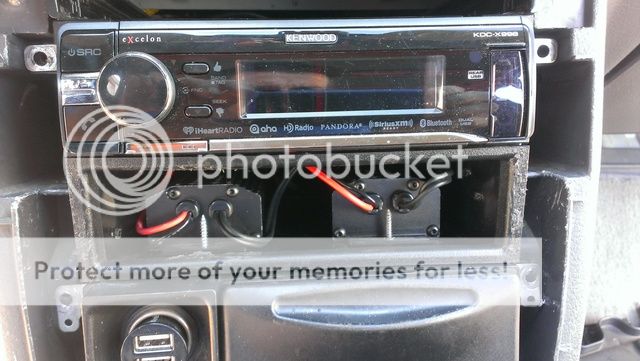
I disconnected the xlr cables from the amp and the noises ceased. One 5200 was supposedly new and the package was opened, it was scratch free, clean and the wires hadn't been cut. The other unit was supposedly from a display board and obviously had been connected. Both were working fine for a few weeks, I'm wondering now if the deck was somehow overdriving them or if any caps could be faulty.
A few days later I removed both converters and reinstalled the rca cables and it sounds good but back to the lack of spl issue the converters were purchased to improve.
The gfi-5200 doesn't have many caps, and several of them are ceramic or mylar. There are only four electrolytic caps with two pre power supply and the other pair on the power supply rails. I ordered panasonic 105c caps to replace all of the electrolytics and some high end mlc for the pair of ceramic caps on the output ends (just because the old tan ones look cheap). I would have asked advice sooner but figured the caps being so old were mandatory.
If anyone could shed some light on the noise issue, I'd appreciate it. Other than me somehow overdriving the input stages, I'm not sure how they could be damaged. It wouldn't seem the LM347n op amps would be faulty just from age. There are many resistors in these converter though, and hopefully I don't have to test them all.
Here is where they were:

Last edited:
I am also curious if doing something like swapping in LM6154 op amps would be a straight forward task or if I would need to adjust some of the components to compensate for the spec changes of the new IC. It seems like someone was mentioning "improvements" to these balanced converters, maybe it wasn't on diyaudio. The LM6154 is SOIC style vs the previous DIP package of the LF347N, but that could be easily adapted with a DIP to SOIC adapter.
Lots of views but no comments, meh.  Here's a pic of one of my gfi-5200 balanced drivers since you don't see these pics on the web for some reason. I am replacing every capacitor, just waiting on the replacements for the two large red mylars. I'm also going to check the resistors on the input side in case they were somehow overdriven. There is no info I can find on problems with these and rarely any mention of them at all.
Here's a pic of one of my gfi-5200 balanced drivers since you don't see these pics on the web for some reason. I am replacing every capacitor, just waiting on the replacements for the two large red mylars. I'm also going to check the resistors on the input side in case they were somehow overdriven. There is no info I can find on problems with these and rarely any mention of them at all.
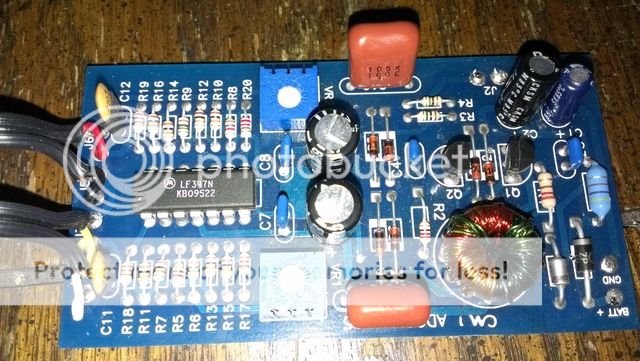



So.... I decided to play around and be the guinea pig (as usual) to take on using a different quad op amp. There is only a short mention of someone doing this online and no follow up or advice. I purchased some LM6154 op amps and some SOIC to DIP adapters. They could very well explode or totally not be compatible with the circuit but someone has to try. The maximum supply voltage on the LF347N is supposedly 36v while the LM6154 is only 24. The two rail caps only add up to 32v so I will power up one and read what it is regulated to.
Did the capacitor swaps on both gfi-5200 today, haven't noticed the weird sounds yet.
Before:
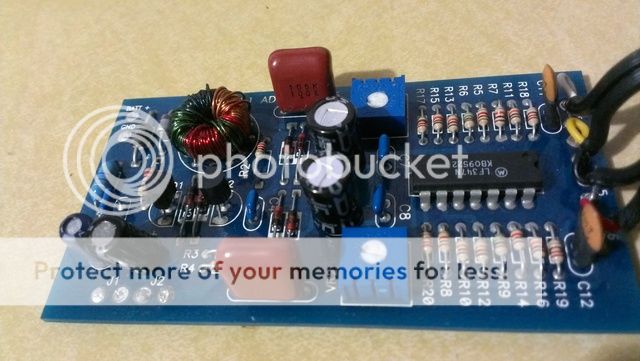
After:
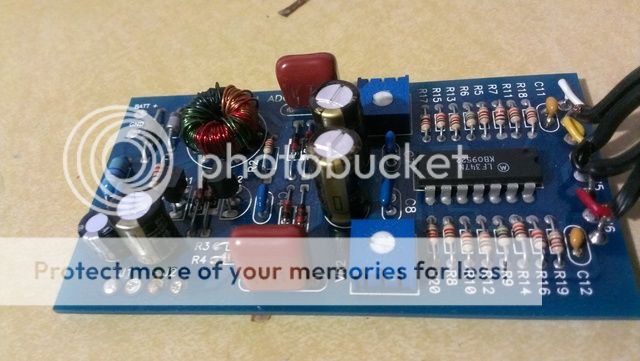
The 105c caps were actually larger and the newer disc caps were smaller, I used the same panasonic part for the burgundy mylars. The new rail caps were several mm from the case, good clearance. I measured total rail voltage at 29v for anyone curious. I'm not sure the LM6154 chips will be ok with that, so they are on hold until I find out if they will work. New caps on top
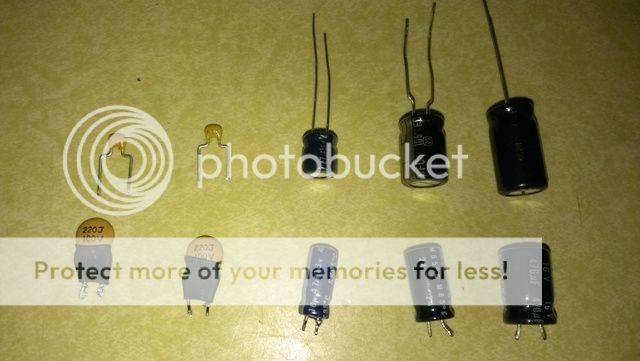
Before:

After:

The 105c caps were actually larger and the newer disc caps were smaller, I used the same panasonic part for the burgundy mylars. The new rail caps were several mm from the case, good clearance. I measured total rail voltage at 29v for anyone curious. I'm not sure the LM6154 chips will be ok with that, so they are on hold until I find out if they will work. New caps on top

Last edited:
The static / crackling noise has returned starting with the really cold weather, and stops when the system has been running for a couple of minutes. I am not sure if it's something like leaking caps or transistor issues in the 5450 or something in the 5200s.
I have all of the replacement caps ready for the amplifier, just not wanting to remove the amp as I've grown fond of the sound since install and don't have a small 4 channel to temporarily use. I've been running my front components on two channels and some subs on the others.
Yesterday I removed the 5200s and reconnected the amp with rcas temporarily. Hopefully we will have a cold snap again soon and I will be able to recreate (or not) the cold weather noises. I'm hoping it's something to do with the 5200s because I've already looked around in the 5450 and couldn't find any signs of capacitor leakage or solder issues. I'd much rather deal with the fewer components in the 5200s haha.
Still on the lookout for the four channel version of the 5200s as well. (gfi-5400?)
I have all of the replacement caps ready for the amplifier, just not wanting to remove the amp as I've grown fond of the sound since install and don't have a small 4 channel to temporarily use. I've been running my front components on two channels and some subs on the others.
Yesterday I removed the 5200s and reconnected the amp with rcas temporarily. Hopefully we will have a cold snap again soon and I will be able to recreate (or not) the cold weather noises. I'm hoping it's something to do with the 5200s because I've already looked around in the 5450 and couldn't find any signs of capacitor leakage or solder issues. I'd much rather deal with the fewer components in the 5200s haha.
Still on the lookout for the four channel version of the 5200s as well. (gfi-5400?)
The amplifier didn't make the cold start noises without the 5200s installed. I just replaced the op amps in both 5200s and will see if the noise resurfaces. It does seem like the sq is worse with the drivers installed though, pretty sure the xlr connectors are pinned correctly but maybe I should quadruple check. It's like phase at many frequencies isn't correct and the mid/high speakers aren't quite in phase with the subwoofers, but when running direct rca level from the deck it sounds great...just doesn't allow as much spl.
I've already tried reversing the amplifier output on one channel which completely cancels all bass response and leads me to believe the input cable wiring is correct but it still may not be. You can also fade left or right and bass level decreases, which is an easy method. It just seems something is out of phase, and even the higher mid / lower treble output seems not as crisp, almost like it's being scrambled inside the converters.
I paid close attention to the "hot" and "cold" output from the converters and made sure the cables were pinned as per adcom's site, even removed, restripped, and resoldered all of the output cables on the converters because a few had brittle connections at the board. Pics were taken to be sure I didn't reinstall any of the wires out of order. I will likely remove them again in a few days and meter all connections with the output cables connected to see if there is any way I connected anything wrong.
I paid close attention to the "hot" and "cold" output from the converters and made sure the cables were pinned as per adcom's site, even removed, restripped, and resoldered all of the output cables on the converters because a few had brittle connections at the board. Pics were taken to be sure I didn't reinstall any of the wires out of order. I will likely remove them again in a few days and meter all connections with the output cables connected to see if there is any way I connected anything wrong.
It was my mistake not buying a two channel dso, and I really don't understand how to use my single channel yet so just being a "parts changer" for now. So If I had a two channel dso, would I need need to:
1-split a full range channel with an rca "y" splitter at the deck
2-run the same channel into left and right inputs of the 5200
3-compare the left and right "hot" output and then the left and right "cold" outputs?
So far I've replaced the electrolytic caps and larger and smaller mylar and ceramic caps (just for age) and the op amps in both 5200 drivers. I am worried the op amps could have somehow decreased the sq even if they did remedy the crackling. The op amps were purchased as motorola, but arrived as another brand (imagine that). It wasn't difficult replacing them, just the idea of tampering with the 5200 output wiring is a little aggravating, they are very delicate and I've already had to re strip and solder them. Yesterday (again) I did check all xlr cable pins and compare them from the output pins of the 5200 to the amplifier, they all were correct. I also removed both output ends of the 5200s and made sure "hot" and "cold" and shield polarities were all correct, and they were.
The system sounds so much better sonically without the balanced drivers, really makes me wonder if they just actually suck that much. I really don't see why they would have been included with the amplifiers if they were crap, especially since most decks of that time period had very low preamp voltage. Seriously, what decks were the adcom amps designed for in the early to mid 90s, only the highest end kenwoods with 8v output or the high end "high" voltage alpine decks? That would seem like a very limited market.
These converters also seem to be very advanced and well made (at least visually), although phoenix gold made similar ones, and fosgate is now making balanced drivers as well. What amazes me is that the fosgate ones are so (pointlessly) huge compared to the adcom and phoenix gold versions. I pulled an end cap just to check one of the fosgate and was amazed how little there was inside, it could be 1/4 the size if they desired.
I also picked up two more 5200s still in original boxes if needed, and may sell or trade them if a 5400 rears its head.
1-split a full range channel with an rca "y" splitter at the deck
2-run the same channel into left and right inputs of the 5200
3-compare the left and right "hot" output and then the left and right "cold" outputs?
So far I've replaced the electrolytic caps and larger and smaller mylar and ceramic caps (just for age) and the op amps in both 5200 drivers. I am worried the op amps could have somehow decreased the sq even if they did remedy the crackling. The op amps were purchased as motorola, but arrived as another brand (imagine that). It wasn't difficult replacing them, just the idea of tampering with the 5200 output wiring is a little aggravating, they are very delicate and I've already had to re strip and solder them. Yesterday (again) I did check all xlr cable pins and compare them from the output pins of the 5200 to the amplifier, they all were correct. I also removed both output ends of the 5200s and made sure "hot" and "cold" and shield polarities were all correct, and they were.
The system sounds so much better sonically without the balanced drivers, really makes me wonder if they just actually suck that much. I really don't see why they would have been included with the amplifiers if they were crap, especially since most decks of that time period had very low preamp voltage. Seriously, what decks were the adcom amps designed for in the early to mid 90s, only the highest end kenwoods with 8v output or the high end "high" voltage alpine decks? That would seem like a very limited market.
These converters also seem to be very advanced and well made (at least visually), although phoenix gold made similar ones, and fosgate is now making balanced drivers as well. What amazes me is that the fosgate ones are so (pointlessly) huge compared to the adcom and phoenix gold versions. I pulled an end cap just to check one of the fosgate and was amazed how little there was inside, it could be 1/4 the size if they desired.
I also picked up two more 5200s still in original boxes if needed, and may sell or trade them if a 5400 rears its head.
Last edited:
You don't need a digital storage scope. A CRT based analog scope will do most everything that you will ever need.
Mono sine wave out of the head unit. Check those to confirm that everything is flat and in phase and then do the same at the output of the amp. The probes will be on the active outputs of the amp. The other speaker terminals don't have signal, nothing to check.
Mono sine wave out of the head unit. Check those to confirm that everything is flat and in phase and then do the same at the output of the amp. The probes will be on the active outputs of the amp. The other speaker terminals don't have signal, nothing to check.
I understand what you are saying about a crt scope working for this situation, but would a dual channel digital scope not work also? The crt scanners are pretty bulky, a used one could be out of calibration or have other issues, and a new one is pretty pricey unless I'm continually using it for servicing electronics. I only need something like this occasionally, which is why I purchased the single channel scope but didn't think about needing more than one channel. You may have noticed this situation and the old amp I needed your help on a while back have been the only situations I could have used a scope with.
I bought a gfi 4400 on fleabay and it seems to be in new condition. It only has seven electrolytics so I have panasonic 105c replacements ready to go in. Just waiting on a hot air desoldering gun, going to see if it makes the job cleaner. This gfi seems to be small enough to fit under the deck and all connectors point back so the deck to gfi cables will be very short and the xlrs will plug right in.
The only reason I could think of for the weird sound at cold start up would possibly be the fact I was running two 5200s into the one amp and they both have their own power supply. Is it possible that fluctuations between the two could have been causing voltage swings in the output circuits that conflicted with each other between channels causing the audible strange noises? Hopefully I don't have the same issue with the 4400, either way the 5450 will be getting recapped as well soon.
I now have two new/unused gfi 5200s in boxes and two others that I converted to xlr 5pin out and replaced all electrolytics with 105c panasonics if anyone is interested. I'd put them on fleabay but they are raping small volume sellers like no tomorrow. :/
The only reason I could think of for the weird sound at cold start up would possibly be the fact I was running two 5200s into the one amp and they both have their own power supply. Is it possible that fluctuations between the two could have been causing voltage swings in the output circuits that conflicted with each other between channels causing the audible strange noises? Hopefully I don't have the same issue with the 4400, either way the 5450 will be getting recapped as well soon.
I now have two new/unused gfi 5200s in boxes and two others that I converted to xlr 5pin out and replaced all electrolytics with 105c panasonics if anyone is interested. I'd put them on fleabay but they are raping small volume sellers like no tomorrow. :/
Last edited:
- Status
- This old topic is closed. If you want to reopen this topic, contact a moderator using the "Report Post" button.
- Home
- General Interest
- Car Audio
- gfa-5450 needs more line input voltage